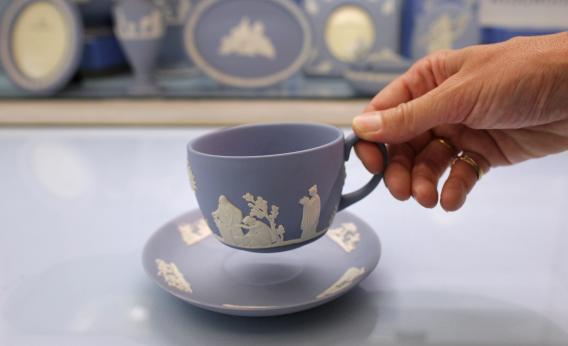A reader recently wrote in to ask: Why is tea made with microwave-heated water so lousy compared to tea made with water boiled in a kettle?
Because a proper cup of black tea must be made with water that’s come to a rolling boil. A kettle is designed to heat water evenly to 212 degrees Fahrenheit. Heat at the bottom of the kettle—whether from a heating element embedded in an electric device or from a burner on the stove—creates a natural convection current: The hot water rises and the cool water falls in a cyclical fashion, which uniformly heats the contents of the kettle to a boil (at which point an electric kettle clicks off or a stovetop kettle whistles).
But microwaves don’t heat water evenly, so the boiling process is difficult to control. Microwave ovens shoot tiny waves into the liquid at random locations, causing the water molecules at those points to vibrate rapidly. If the water isn’t heated for long enough, the result is isolated pockets of very hot or boiling water amid a larger body of water that’s cooler. Such water may misleadingly exhibit signs of boiling despite not being a uniform 212 degrees. For instance, what appears to be steam rising from a mug of microwaved water is only moist vapor evaporating off the water’s surface and condensing into mist on contact with cooler air—it’s the same principle that makes our breath visible on frigid days.
Why is water temperature so important to good-tasting tea? When tea leaves meet hot water, hundreds of different compounds that contribute flavor and aroma dissolve and become suspended in the water. Black tea contains two kinds of complex phenolic molecules, also known as tannins: orange-colored theaflavins and red-brown thearubigins. These are responsible for the color and the astringent, brisk taste of brewed black tea, and they are extracted only at near-boiling temperatures.
Water also cooks certain volatile compounds, chemically altering them to produce more nuanced flavors and aromas, such as the earthy, malty, and tobacco notes in black tea. When the water isn’t hot enough to instigate these reactions and produce these bold flavors, tea tastes insipid.
Overheated water results in bad tea, too—and this is also easier to do in a microwave than in a kettle, since there’s no mechanism to indicate when the water has reached a boil. The longer water boils, the more dissolved oxygen it loses—and tea experts say that dissolved oxygen is crucial for a bright and refreshing brew. Microwaved water can also be taken to several degrees above boiling if heated for too long (which is impossible in a kettle, because the metallic surface prevents overheating). Such ultra-hot water destroys desired aromatic compounds and elicits an excess of astringent, bitter notes by overcooking the leaves. Overheated water can also accentuate naturally occurring impurities in the water that contribute off flavors to the final brew.
It’s possible that the material of the heating vessel also affects tea’s flavor. Modern day kettles are invariably made from stainless steel. While stainless steel is considered a nonreactive material, research has shown that minuscule amounts of chromium, iron, and nickel can migrate from a container or a utensil into the food. These don’t pose a safety threat, but they may well subtly affect the taste of water boiled in a kettle. In contrast, only glazed ceramics, glass, and plastics are safe to use in microwaves. It’s not inconceivable that the lack of trace metal ions are partly responsible for a lousy cup of microwave tea.
Microwaved water isn’t totally useless for all tea. In fact, water that’s microwaved to below boiling is ideal for green tea. The mellow, brothy flavors prized in green tea are mostly derived from specific savory-tasting amino acids that start to dissolve at 140 degrees. While mouth-puckering tannins are desirable in black tea, with green tea, boiling water extracts too many astringent notes and too much bitter caffeine that would overwhelm the delicate amino acids. Caffeine is extremely soluble at 212 degrees, but significantly less so at 145 to 175 degrees, the ideal temperature range for brewing green tea.
Food Explainer thanks Lou Bloomfield of the University of Virginia, Skip Rochefort of Oregon State University, and tea expert Bruce Richardson.
Have a question about something you’re eating or drinking? Send it to slatefoodexplainer@gmail.com.
Previously from the Food Explainer:
What’s the Difference Between Yogurt and “Cultured Dairy Blend”?
Why Does Tomato Sauce Splatter When It Cooks?
Why Does Steam Make Bread Light and Crusty?
Why Does Eating Hot Chilies Make My Nose Run?
Why Are Some Boiled Eggs Easier To Peel Than Others?
Why Does Fish Sauce Have an Expiration Date?
Why Is Cheese Yellow When Milk Is White?
